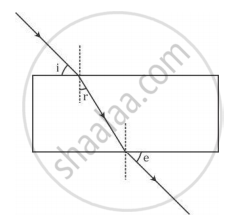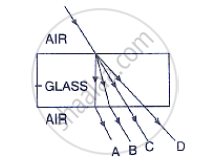Advertisements
Advertisements
Question
A ray of light falls normally on the surface of a transparent glass slab. Draw a ray diagram to show its path and also mark angle of incidence and angle of emergence.
Solution

As the incident light is normal to the surface thus the incidence angle will be zero which will correspond to zero degree refracted angle and zero degree emergent angle.
APPEARS IN
RELATED QUESTIONS
A student traces the path of a ray of light passing through a rectangular glass slab and marks the angle of incidence i, angle of refraction r and angle of emergence e, as shown.

The correctly marked angle(s) is/are
(A) ∠ i only
(B) ∠ e only
(C) ∠ r only
(D) ∠ i and ∠ e
Name a prism required for obtaining a spectrum of Ultraviolet light.
Write the relation between the angle of incidence and the angle of refraction for a medium.
When a lighted candle is held in front of a thick plane glass mirror, several images can be seen, but the second image is the brightest, give reason.
In fig 4.18, name the ray which represents the correct path of light while emerging out through a glass block.

How does the deviation produced by a prism depend on the wavelength of incident light?
The refractive index of glass with respect to air is 3/2. What is the refractive index of air with respect to glass?
Consider these indices of refraction: glass: 1.52; air: 1.0003; water: 1.333. Based on the refractive indices of three materials, arrange the speed of light through them in decreasing order.
